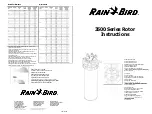
5
the eye should be visible above ground.
Avoid waterlogged soils which have poor holding and
anchor below the frost level.
Low Temperature Operation:
Plastic materials do not
perform well in extreme cold, becoming brittle and
breaking. This applies to wind turbine blades, whether
glass filled or not. Operation at around 0°C should not be
a problem, but most materials are vulnerable at –20°C and
cannot be warranted to survive indefinitely.
Pacific ’s glass filled polypropylene blades, moulded with
large sized fibres in a compression process, are superior to
nylon, carbon polymer or other plastics in this respect.
However, when ice factors are also considered, the
prediction of blade reliability is even more difficult.
Other materials are also suspect. Examples are Nitrile
used in exposed seals and “O” rings and basic PVC cable
sheathing.
For this reason Pacific uses Neoprene and Viton™
components where possible and "Arctic" grade PVC
Grease used in sealed bearings allows performance to
(minus) -30°C or below, but component tolerances (ball
and ring) can lead to greater friction and increased wear
causing reduced bearing life.
Lightning:
Directly earth all metalwork. Bury output
cables (½m depth) between mast and battery position for
better protection than suspending in air. Either run cabling
through plastic conduit or use a type specified for burying.
CHOICE OF MOUNTING: (Boat based)
a)
On an extended. stayed pole on the stern of a boat.
see Figure. 9
b)
On a bracket on the. Mizzen of a yacht, see Figure 3
c)
At the main or mizzen masthead of a yacht.
d)
On a custom made welded pushpit structure, "A"
frame, gantry etc.
PACIFIC STERN MOUNT
(for Marine use)
Very careful attention must be given to the strength and
integrity of the mounting. This should be capable of
withstanding a peak horizontal load of 120kg (250lbs).
Note. The mounting pole should be vertical. The space
between the blade tips and the mounting pole must be left
clear, i.e. no clamps or other items should diminish this
clearance. The pole base should be mounted where the
structure is very rigid. The mounting should not rest on a
resonant surface such as the centre of a cabin roof since
this may transmit any vibration making the machine
audible inside.
a)
Check.
Ensure that a complete and undamaged set of
parts has been received.
b) Pole position.
The pole base fixing may be moved to
one side provided that, when viewed from above, the
angle between the strut and either wire is greater than 45
degrees.
c)
Pole assembly.
Using the joiner tube and M6 x 12
screws and shakeproof washers, assemble the poles .
A thread locking solution (e.g. Loctite 222) will stop
screws shaking loose due to long term vibration.
It may be easier to feed the cable through the poles as they
are assembled.
d)
Feet.
Using the M8 x 65 bolt, washers and nut, fix the
feet to the pole end and screw down the feet.
The feet should be arranged so the pole can pivot in line
with the strut. This usually means aligned fore and aft
unless the pole is off-centre.
e) Stay Wires.
Having assembled the poles with joiner
tubes, site the pole and attach the two stay wires with the
yoke in place on the pole. Find suitable points for the stay
wire base fixings, allowing for the fact that these will be
under considerable tension in use.
"Bottle screws" are suggested as a tensioning method.
Figure 9. Stern Mount Kit
f) Backstay strut.
File the groove in the strut pole end
and clamp shell to accommodate the backstay wire
diameter less 0.5mm. Cut the strut pole to length required.
Drill the hole for the strut to yoke bolt in situ to ensure
correct orientation of holes.
B
C
Summary of Contents for Pacific 100
Page 10: ...10 Fig 8 ...
































